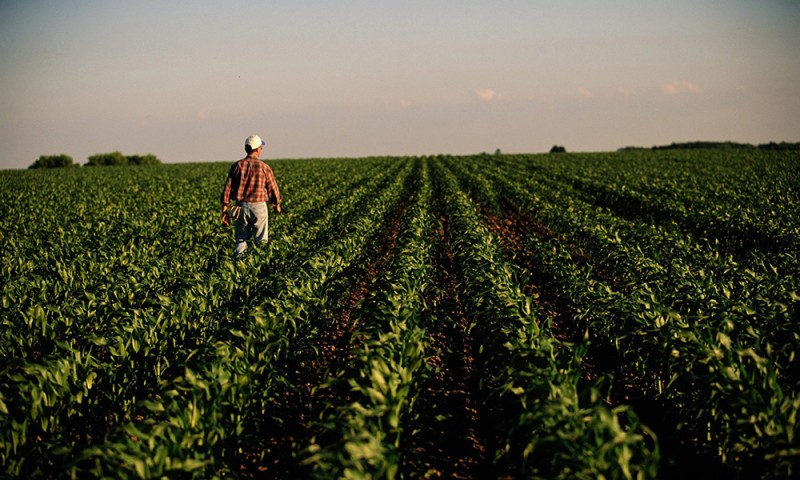
随着近年来农产品价格暴跌以及总统唐纳德·特朗普发起的贸易战对农业造成的冲击,美国玉米和大豆农户接连发出严峻警告。
上周四,美国国家玉米种植者协会(National Corn Growers Association)警示称:“在投入成本仍接近历史高位之际,农产品价格却大幅下跌,美国农村正遭遇一场经济危机。”
该协会表示,玉米价格自2022年达到峰值以来,已暴跌逾50%,而同期生产成本仅下降3%,意味着每蒲式耳要亏损85美分。该协会进一步强调,明年前景更糟,价格将进一步走低,而成本则持续攀升。
该协会呼吁国会和特朗普政府通过提高乙醇掺混比例、扩大海外市场准入等措施提振需求。
一周前,美国大豆协会(American Soybean Association)致信特朗普,警告称:“美国豆农正站在贸易和金融的悬崖边上。”
该协会敦促特朗普在对华贸易谈判中优先考虑大豆议题,争取让中国承诺大规模采购大豆并取消对美国农产品加征的关税。
信中指出:“长期以来,美国一直是中国客户的首选供应方。然而,由于关税,中国的长期客户已经并将继续转向南美竞争对手来满足需求。而巴西自上次中美贸易战以来大幅增产,足以满足这一需求。”
该协会补充称,美国大豆收获季即将来临,但中国尚未采购任何未来数月交货的美国大豆。
信中强调,中美谈判若迟迟未能达成贸易协议,随着秋收季节日益深入,农民承受的压力将愈发沉重。
与玉米种植者一样,大豆种植者也面临价格暴跌与成本高企的双重压力。大豆价格自2022年触顶以来,已下跌约40%。
美国大豆协会表示:“豆农正承受巨大的财务压力。价格持续下跌的同时,投入成本和设备开支却大幅上涨。美国豆农无法在与最大客户的长期贸易争端中生存下去。”
农场收入与信贷状况持续恶化
美联储最新农场金融状况调查印证了农业经济的惨淡景象。调查显示,收入下降削弱了农民的流动性,从而推高了融资需求。
与此同时,信贷环境持续恶化。芝加哥联储和堪萨斯城联储辖区约30%的受访者表示其偿付率低于去年同期;明尼阿波利斯联储辖区该比例约为40%;而在圣路易斯联储辖区,这一比例更是高达50%。
当然,美国农民也将获得大规模援助。特朗普今年初发动新一轮贸易战后,美国政府和国会议员4月起就开始商讨农户纾困方案。
7月签署的《大而美法案》(One Big Beautiful Bill Act)包含约660亿美元农业专项支出。据美国农场局联合会(American Farm Bureau Federation)数据,其中绝大部分资金(约590亿美元)将用于强化农场安全网。
此外,特朗普谈判达成的其他贸易协议也有望推动亚洲多国加大对美国农产品的采购。
例如,印尼和孟加拉国已承诺按照协议增加采购量。本周有消息人士对路透社透露,越南、菲律宾和泰国可能会增加饲料谷物进口量。
美国大豆出口协会(U.S. Soybean Export Council)东南亚及大洋洲区域总监罗启明(Timothy Loh)在接受路透社采访时表示:“近期的贸易磋商卓有成效,为美国拓宽本地区市场准入提供了机会。”
他补充说:“我们预计东南亚对美国豆粕等农产品的需求将进一步增长。”(*)
译者:刘进龙
审校:汪皓
随着近年来农产品价格暴跌以及总统唐纳德·特朗普发起的贸易战对农业造成的冲击,美国玉米和大豆农户接连发出严峻警告。
上周四,美国国家玉米种植者协会(National Corn Growers Association)警示称:“在投入成本仍接近历史高位之际,农产品价格却大幅下跌,美国农村正遭遇一场经济危机。”
该协会表示,玉米价格自2022年达到峰值以来,已暴跌逾50%,而同期生产成本仅下降3%,意味着每蒲式耳要亏损85美分。该协会进一步强调,明年前景更糟,价格将进一步走低,而成本则持续攀升。
该协会呼吁国会和特朗普政府通过提高乙醇掺混比例、扩大海外市场准入等措施提振需求。
一周前,美国大豆协会(American Soybean Association)致信特朗普,警告称:“美国豆农正站在贸易和金融的悬崖边上。”
该协会敦促特朗普在对华贸易谈判中优先考虑大豆议题,争取让中国承诺大规模采购大豆并取消对美国农产品加征的关税。
信中指出:“长期以来,美国一直是中国客户的首选供应方。然而,由于关税,中国的长期客户已经并将继续转向南美竞争对手来满足需求。而巴西自上次中美贸易战以来大幅增产,足以满足这一需求。”
该协会补充称,美国大豆收获季即将来临,但中国尚未采购任何未来数月交货的美国大豆。
信中强调,中美谈判若迟迟未能达成贸易协议,随着秋收季节日益深入,农民承受的压力将愈发沉重。
与玉米种植者一样,大豆种植者也面临价格暴跌与成本高企的双重压力。大豆价格自2022年触顶以来,已下跌约40%。
美国大豆协会表示:“豆农正承受巨大的财务压力。价格持续下跌的同时,投入成本和设备开支却大幅上涨。美国豆农无法在与最大客户的长期贸易争端中生存下去。”
农场收入与信贷状况持续恶化
美联储最新农场金融状况调查印证了农业经济的惨淡景象。调查显示,收入下降削弱了农民的流动性,从而推高了融资需求。
与此同时,信贷环境持续恶化。芝加哥联储和堪萨斯城联储辖区约30%的受访者表示其偿付率低于去年同期;明尼阿波利斯联储辖区该比例约为40%;而在圣路易斯联储辖区,这一比例更是高达50%。
当然,美国农民也将获得大规模援助。特朗普今年初发动新一轮贸易战后,美国政府和国会议员4月起就开始商讨农户纾困方案。
7月签署的《大而美法案》(One Big Beautiful Bill Act)包含约660亿美元农业专项支出。据美国农场局联合会(American Farm Bureau Federation)数据,其中绝大部分资金(约590亿美元)将用于强化农场安全网。
此外,特朗普谈判达成的其他贸易协议也有望推动亚洲多国加大对美国农产品的采购。
例如,印尼和孟加拉国已承诺按照协议增加采购量。本周有消息人士对路透社透露,越南、菲律宾和泰国可能会增加饲料谷物进口量。
美国大豆出口协会(U.S. Soybean Export Council)东南亚及大洋洲区域总监罗启明(Timothy Loh)在接受路透社采访时表示:“近期的贸易磋商卓有成效,为美国拓宽本地区市场准入提供了机会。”
他补充说:“我们预计东南亚对美国豆粕等农产品的需求将进一步增长。”(*)
译者:刘进龙
审校:汪皓
U.S. producers of corn and soybeans have sent dire warnings as prices for their crops have crashed in recent years while President Donald Trump’s trade war whipsaws farmers.
On Thursday, the National Corn Growers Association raised alarms about “the economic crisis hitting rural America, as commodity prices drop at a time when input costs remain at near-record highs.”
Corn prices have plunged more than 50% from their 2022 peak, while production costs are down just 3% in that span, translating to a loss of 85 cents per bushel, the NCGA said, adding that the outlook for next year is worse with even lower prices and higher costs.
The NCGA called on Congress and the Trump administration to boost demand, including via higher blends of ethanol and increased foreign market access.
A week before that, the American Soybean Association sent a letter to Trump, warning that “U.S. soybean farmers are standing at a trade and financial precipice.”
The group asked that Trump prioritize soybeans in trade talks with China, seeking major purchase commitments as well as the removal of Beijing’s duties on the U.S.
“Historically, the U.S. was the provider of choice for Chinese customers,” the letter said. “However, due to ongoing tariff retaliation, our longstanding customers in China have and will continue to turn to our competitors in South America to meet their demand, a demand Brazil can meet due to significantly increased production since the previous trade war with China.”
With harvest season fast approaching, the association added that China hasn’t purchased any U.S. soybeans for the months ahead.
The longer negotiations with China drag on without a trade deal—and the deeper farmers go into the fall— the more pain they will feel, it said.
Like the corn growers, the soybean growers also cited sharply lower prices and high costs. Since peaking in 2022, soybean prices have fallen about 40%.
“Soybean farmers are under extreme financial stress,” the group said. “Prices continue to drop and at the same time our farmers are paying significantly more for inputs and equipment. U.S. soybean farmers cannot survive a prolonged trade dispute with our largest customer.”
Farm incomes, credit conditions deteriorate
The bleak picture of the agricultural economy was echoed by the Federal Reserve’s latest survey of farm financial conditions. It found that weaker income has reduced liquidity for farmers, boosting demand for financing.
At the same time, credit conditions deteriorated with roughly 30% of respondents in the Chicago Fed and Kansas City Fed districts reporting lower repayment rates versus a year ago, while the Minneapolis Fed region’s share was around 40% and the St. Louis Fed’s was 50%.
To be sure, U.S. farmers are set to receive substantial help. After Trump launched his latest trade war earlier this year, the administration and lawmakers began talking about a bailout for farmers in April, similar to how they received a bailout during Trump’s first term, when he waged a trade war against China.
The One Big Beautiful Bill Act that was signed in July included about $66 billion in agriculture-focused spending. The vast majority, about $59 billion, is earmarked for farm safety-net enhancements, according to the American Farm Bureau Federation.
In addition, other trade deals Trump has negotiated should see countries elsewhere in Asia step up purchases of U.S. crops.
For example Indonesia and Bangladesh have agreed to boost buying under their agreements, and sources told Reuters this past week that Vietnam, the Philippines and Thailand may increase feed grain purchases.
“There have been productive trade discussions which present an opportunity for the U.S. to strengthen its access to markets in our region,” said Timothy Loh, the U.S. Soybean Export Council’s regional director for Southeast Asia & Oceania, told Reuters.
“We are anticipating higher demand for U.S. products such as soymeal and other U.S. agricultural exports into Southeast Asia.”

